There are 23 different species of snakes in Nevada, several of them being venomous. Nevada is home to about 6 venomous snakes that you will have to look out for if you happen to go hiking or on nature walks.
Some venomous snakes that roam the state include the Mojave Green Rattler, Panamint Rattlesnake, Mojave Desert Sidewinder, Speckled Rattlesnake, Great Basin Rattlesnake, and Western Diamondback Rattler.
Rattlesnakes are not protected by the state of Nevada, along with all other species. According to the Nevada Fish and Wildlife Office, the only protected snake species of the state include the Sonoran Mountain Kingsnakes and the Rosy Boa due to destructive commercial transactions.
The following species are illegal to import or possess in the state of Nevada: Coral snakes, cobras, mambas, kraits, all Elapidae family, except ones in the subspecies Hydrophiinae, Australian elapids, pit vipers not indigenous to the state, true vipers not indigenous to the state, All Viperidae family not indigenous to the state.
Most poisonous and large constrictor snakes are legal to the state but may be illegal in some counties as well as the city of Las Vegas. Henderson and Clark Counties are typically local areas that prohibit these species.
If you live in the city of Las Vegas, you will need a Wild Animal Permit in order to collect or possess any snakes that are either venomous or over eight feet long. You also cannot import any indigenous species without a permit.
Table of Contents
Common Snakes in Nevada
Here are some common snakes that roam the state:
1. Wandering Garter Snake

- Experience Level: Beginner
- Family: Colubridae
- Scientific Name: Thamnophis elegans vagrans
- Other Names: Terrestrial Garter Snake
- Adult Size: 18 to 43 inches
- Lifespan: 6 to 12 years in captivity; 2 years in the wild
Wandering Garter Snakes are typically gray or gray-brown covered in a black checkered pattern and three cream-colored stripes running down the top and sides of their body.
They prefer to inhabit riparian habitats as well as any other areas with moist climates like lakes, ponds, and wet meadows. You can also find them in sagebrush and coniferous forests.
They will hunt for fish, mollusks, tadpoles, and amphibians in water but will also eat insects like grasshoppers, as well as small vertebrates like birds, reptiles, and mice.
2. Western Threadsnake

- Experience Level: Intermediate
- Family: Leptotyphlopidae
- Scientific Name: Rena humilis
- Other Names: Western Blind Snake, Western Slender Blind Snake
- Adult Size: 16 inches
- Lifespan: 10 to 18 years
While you can keep these as pets, they are a very secretive species with specific care requirements. They are nocturnal beings that prefer to live underground and do not like coming out into the light, which is why we don’t know much about them.
They basically look like your typical earthworm. They might be pink, tan, light or dark brown, black, and even gray in color.
Texas Blind Snakes will often frequent ant burrows and termite hills where they will eat these insects as well as their eggs, pupae, and larvae.
3. Glossy Snake

- Experience Level: Beginner
- Family: Colubridae
- Scientific Name: Arizona elegans
- Other Names: Faded Snake
- Adult Size: 30 to 50 inches
- Lifespan: 10 to 18 years
These slow-slithering, nocturnal beings look very similar to gopher snakes with pointed, narrow heads and similar coloration.
They have tan to light brown bodies with a faded look, hence their names, and brown blotches all throughout their length. Their undersides are typically cream or pale yellow in color and they have shiny-looking scales, giving them an almost glossy finish.
They are fairly large in size and are pretty easy-going, making them good pets as well.
They like to inhabit dry areas such as grasslands, deserts, sagebrush, chaparral, and pine-juniper.
They mainly feed on vertebrates such as lizards, rodents, smaller snakes, smaller birds, and sometimes insects. They consume their prey by constricting them with their tight grip, suffocating them, then eating them whole.
4. Western Shovelnose Snake

- Experience Level: Intermediate
- Family: Colubridae
- Scientific Name: Chionactis occipitalis
- Other Names: Shovel-nosed Snake
- Adult Size: 10 to 17 inches
- Lifespan: Unknown
These tan or pale yellow snakes will typically have completely black, dark brown saddle-like striping along their backs, sometimes alternating red-orange.
They are true to their name with a flattened, shovel-like beak and an inset jaw which they can use to bury themselves under sand quickly and efficiently.
These nocturnal creatures are harmless to humans and can be found in rocky canyons, valleys, and sandy deserts. They mostly occur in the later habitat since they enjoy sand dunes.
Their diet includes small invertebrates such as scorpions, spiders, crickets, centipedes, and moth or beetle larvae.
There are about 3 subspecies that can be found in Nevada.
5. Yellow-bellied Racer

- Experience Level: Intermediate
- Family: Colubridae
- Scientific Name: Coluber constrictor mormon
- Other Names: Western Yellowbelly Racer, Western Racer
- Adult Size: 20 to 75 inches
- Lifespan: 7 to 8 years
Yellowbelly Racers usually have large eyes, a broad head with a slender neck, and a long, skinny tail. They are smooth-scaled and are typically blue-gray, brown, or olive green in color.
As you might have guessed by the name, they usually have a yellow or off-white underside.
They like a wide range of habitats like arid or moist environments including sierras, foothills, and plain woodlands.
They feed on insects, amphibians, lizards, other snakes, reptile eggs, birds, and their eggs as well. While they aren’t contractors, they will coil their prey, pinning them down before swallowing them whole.
6. Coachwhip

- Experience Level: Expert
- Family: Colubridae
- Scientific Name: Coluber Masticophis flagellum
- Other Names: Whipsnake
- Adult Size: 5 to 8 feet
- Lifespan: 16 to 20 years in captivity; Wild lifespan: 13 years
Coachwhips are thought to be some of the quickest snakes in America.
Coachwhips are fairly slender with distinctive black or dark brown head and ombre colorations with lighter browns and tans down their backs toward their tail.
They have large eyes, which give them great vision as they swiftly sweep the terrain for prey.
You can find them in any dry terrain such as prairies, farmlands, deserts, shrublands, juniper grasslands, creek valleys, and chaparral. You might also find them roaming around agricultural areas with vegetation.
They eat a diet of mainly rodents, frogs, lizards, birds, and their eggs, spiders, and even small venomous snakes. They are also known to eat rattlesnakes if they happen to cross paths with one.
7. Ringneck
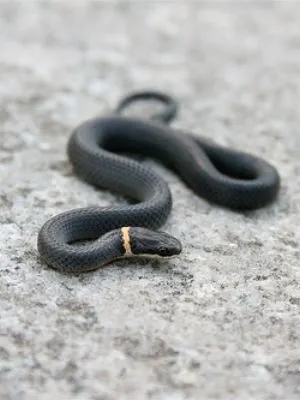
- Experience Level: Intermediate
- Family: Colubridae
- Scientific Name: Diadophis punctatus
- Other Names: Ring-necked Snake
- Adult Size: 10 to 15 inches
- Lifespan: 20 years in the wild; 6 years in captivity
Ringneck Snakes have slender bodies and smooth scales, ranging from black, bluish-black, greenish-gray, to olive in color. Their undersides will usually be yellow, orange, or red with a ring around their neck of the same color.
You can find these snakes in wide varieties of habitats as long as there is a lot of places for them to hide and take cover. They like making dens under woody debris.
They mainly feed on terrestrial worms, mollusks, and amphibians.
There is one other subspecies of Ringsnake in Nevada, the Regal Ringneck Snake or Diadophis punctatus regalis.
8. Kingsnake
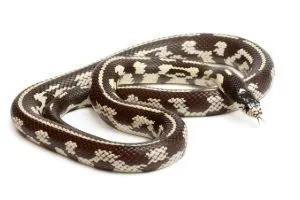
- Experience Level: Beginner
- Family: Colubridae
- Scientific Name: Lampropeltis getula
- Other Names: Eastern Kingsnake, Common Kingsnake, Chain Kingsnake
- Adult Size: 60 inches
- Lifespan: 25 years in captivity; 5.5 years in the wild
Kingsnakes come in many different patterns, varying from black to dark browns, with pale yellow or white spots, rings, bars, bands, or stripes. They have smooth scales to show off their vibrant colorations and chain-link pattern.
They can inhabit various types of habitats but are mostly spotted in grasslands, forests, rocky fields, and deserts. They might also be found near swamps or riverbanks now and again.
Kingsnakes mainly feed on rodents, lizards, birds, and their eggs. In wetter climates, they might consume amphibians and turtle eggs as well.
About 5 other subspecies of Kingsnake can be found in Nevada.
9. Striped Whipsnake
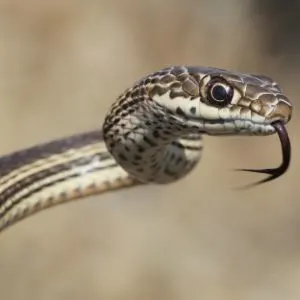
- Experience Level: Expert
- Family: Colubridae
- Scientific Name: Coluber Masticophis taeniatus taeniatus
- Other Names: DesertStriped Whipsnake
- Adult Size: 24 to 67 inches
- Lifespan: anywhere from 10 to 20 years
Desert Striped Whipsnakes are typically black, dark brown, or gray in color with a blue or olive tint to their skin. They have two pale yellow stripes along their backsides all throughout their length.
Their undersides are usually pale yellow or cream from the head fading into a coral red toward the tail.
They can be found in various habitats such as grasslands, canyons, sagebrush flats, shrublands, pine-oak forests, and juniper woodlands. However, they typically prefer rocky streams, mountains, and flatlands.
This species of snake eats smaller mammals, birds, their eggs, amphibians, other snakes including rattlesnakes, and insects.
10. Spotted Leaf-nosed Snake

- Experience Level: Intermediate
- Family: Colubridae
- Scientific Name: Phyllorhynchus decurtatus
- Other Names: Leaf-nosed Snake
- Adult Size: 6 to 20 inches
- Lifespan: Unknown
Leaf-Nosed Snakes can make cool pets, but they do stress easily, meaning that they are better in the hands of experienced keepers. When they are handled, they will defecate, releasing a very foul smell in defense.
They are small and pale with smooth scales and a blunt snout. Their pale pink or off-white bodies will typically have darker brown blotches, mainly on their backs.
They like rocky desert areas and sandy flats with some shrubbery.
They mostly eat lizards eggs and apparently love the tails of Banded Geckos specifically. They are seen to respond positively to eating tails both in and out of their natural environment.
11. Great Basin Gopher Snake

- Experience Level: Intermediate
- Family: Colubridae
- Scientific Name: Pituophis catenifer deserticola
- Other Names: Bullsnake, Bull Snake
- Adult Size: up to 7 feet
- Lifespan: up to 30 years in captivity; 12 years in the wild
Bullsnakes are a subspecies of the Gophersnake. They can make good pets once accustomed to handling and captivity, which is why you want to look for captive-bred species.
They are large constrictor snakes, though, meaning that they strangle their prey. This species will sometimes do this to more than one animal at a time. You also shouldn’t be too surprised if they try to bite.
Bullsnakes are often mistaken for rattlesnakes due to their similar behaviors. However, they are not as large, have round pupils, narrower heads, don’t have pits over their nostrils, and don’t have rattles on their tails.
These non-venomous snakes are hefty and large with a cream-colored or pale yellow body with brown, black, or copper blotching all throughout. Their heads and necks are almost the same in width as well.
They can be found in open country environments like old fields, native or bluff prairies, pastures, oak savannas, and steep hillsides. They roam sandy-soiled areas where rodents burrow and may also take shelter in agricultural fields, open forests, brush, and any sandy area.
These powerful constrictors live off gophers as well as other small mammals like mice and squirrels. They will also consume amphibians, birds, and their eggs.
12. Gophersnake

- Experience Level: Intermediate
- Family: Colubridae
- Scientific Name: Pituophis catenifer
- Other Names: Gopher Snake
- Adult Size: 4 to 7 feet; can reach up to 9 feet
- Lifespan: 12 to 15 years; up to 30 years in captivity
The Gopher Snakes are heavy-bodied, docile creatures except when threatened.
These guys will require a very secure enclosure as they are escape artists. They also require a lot of space due to their size and active nature.
Gopher snakes are usually a light tan to brown color with large, dark brown, sometimes reddish-brown spots and lined patterns throughout their length.
They can be found in pine or oak barrens, savannas, and sand prairies where they do a great job at keeping gopher populations from overabundance.
They really like to eat small rodents, which is actually how they got their name.
13. Long-nosed Snake

- Experience Level: Expert
- Family: Colubridae
- Scientific Name: Rhinocheilus lecontei
- Other Names: Long-nosed Snake
- Adult Size: 30 to 40 inches
- Lifespan: less than 20 years
Long-nosed Snakes are not commonly found in the pet trade because they are difficult to keep since they are notorious escape artists.
They get their name from their slightly upturned, long snout somewhat resembling a shark nose.
They look very similar to a Coral Snake or Milk Snakes with their black and red-orange stripe-like pattern except Long-nosed snakes will have somewhat faded-looking sides which are almost a checkered pattern of the same colors as their body. They also have a light yellow or cream-colored body, which looks like a background under other colors.
These nocturnal beings like arid environments such as deserts and dry prairies where they burrow during the day and crawl on cool roads at night.
These snakes feed primarily on amphibians and lizards but will sometimes be caught eating other smaller snakes and the occasional rodent.
14. Western Patch-Nosed Snake

- Experience Level: Beginner
- Family: Colubridae
- Scientific Name: Salvadora hexalepis
- Other Names: Western Patchnose Snake
- Adult Size: 10 to 46 inches
- Lifespan: 14 years in captivity
These beige-colored snakes have back striping on their sides and a light tan one straight down the middle of their length.
They are diurnal and can be found in sagebrush, grassland areas, pinyon-juniper, and deserts, mostly. They feed on other snakes, lizards, reptile eggs, and smaller rodents in these arid desert environments.
There are about 2 subspecies that can be found in Nevada.
15. Western Ground Snake
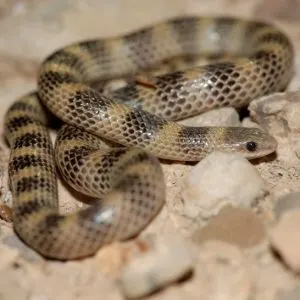
- Experience Level: Beginner
- Family: Colubridae
- Scientific Name: Sonora semiannulata
- Other Names: Variable Ground Snake, Ground Snake, Common Ground Snake
- Adult Size: 8 to 19 inches
- Lifespan: an estimated 15 years
Ground Snakes will vary in color depending on the individual. Some may be brown, red, or orange. They will usually have a black banding with orange or brown blotches that look like stripes.
Their undersides are solid white or gray. They have smooth scales, round pupils, and a smaller head.
They like to inhabit arid environments that have loose, sandy soil or rocky areas like low desert shrubbery, rims of canyons, outcroppings, and slopes.
It is hard to run into these snakes since they are always hiding in debris, but they will usually come out when the sun is about to set. They have been spotted on desert roads before.
Ground Snakes eat invertebrates like spiders, centipedes, crickets, scorpions, and larvae.
16. Smith’s Black-headed Snake

- Experience Level: Intermediate
- Family: Colubridae
- Scientific Name: Tantilla hobartsmithi
- Other Names: Southwestern Blackhead Snake
- Adult Size: 8 inches
- Lifespan: Unknown
This slender snake has a light brown or tan body with a black head, as their name suggests. Their undersides are typically almost lavender in color with a red line through the middle.
They can be found in desert scrub areas, semi-desert grasslands, plains, oak woodlands, and pine-oak woodlands.
They consume caterpillars, centipedes, and beetle larvae.
17. Sonoran Lyre Snake

- Experience Level: Intermediate
- Family: Colubridae
- Scientific Name: Trimorphodon lambda
- Other Names: Sonoran Lyresnake
- Adult Size: 4 feet
- Lifespan: 5.3 years
While Lyresnakes can make great pets and have an unusual look to them, they are quite feisty and can be aggressive eaters. They are also quite the escape artist, so it will take someone who knows what they’re doing to take care of them.
When they act out in defense, they will first coil up then strike.
Since Sonoran Lyre Snakes come from rocky habitats, they match their environment with a gray to light brown coloration. They also have large tan or brown dorsal blotches that are outlined by darker edges.
They are nocturnal terrestrial snakes that prefer to live in dry climates, searching for rocky crevices for prey and slithering across desert roads after the sun goes down.
They feed primarily on lizards but will also eat smaller mammals, birds, bats, as well as other snakes.
About 2 subspecies of this snake can be found in Nevada.
Venomous Snake Species in Nevada
Here is a list of the most venomous snakes that roam the state:
18. Mojave Rattlesnake

- Experience Level: Expert
- Family: Viperidae
- Scientific Name: Crotalus scutulatus
- Other Names: Mojave Green Rattlesnake
- Adult Size: up to 4 feet
- Lifespan: 10 to 15 years
Mojave Rattlesnakes are heavy-bodied and have a large, triangular head.
They are typically brown or pale green, depending on the area they are from. They have brown blotches all over their back across their length.
This species of rattlesnake inhabits lower mountain slopes and high desert areas. They live in various environments anywhere from dry deserts to grasslands.
They like to hide in shrubbery and bushes.
These carnivores consume mainly small rodents, lizards, birds, and toads. They like to eat mice, rats, and rabbits when picking rodents.
19. Panamint Rattlesnake

- Experience Level: Expert
- Family: Viperidae
- Scientific Name: Crotalus mitchellii stephensi
- Other Names: Owens Valley Rattler, Tiger Rattlesnake
- Adult Size: 23 to 52 inches
- Lifespan: 12 years
The Panamint Rattler is typically tan, yellow, or orange with red, orange, or brown saddle-like bands throughout its back.
They like arid environments around rocky sandy valleys. Here, they feed on birds, lizards, and smaller mammals. Larger individuals might also consume smaller rabbits or larger lizards.
They use their head, which has sensors on each side to help detect the warmth of nearby prey.
20. Mojave Desert Sidewinder

- Experience Level: Expert
- Family: Viperidae
- Scientific Name: Crotalus cerastes
- Other Names: Horned Rattlesnake, Sidewinder Rattlesnake
- Adult Size: 17 to 33 inches
- Lifespan: 10 years
Sidewinders are typically light tan, cream, gray, pink, or a sandy paly yellow in color with dark tan, yellow, or gray patches along their back with small dots throughout each of their sides. They have rough, keeled scales and a dark eye stripe that looks as if it’s smudged, extending toward the back of their head.
They can be found in arid environments along rocky hillsides, desert sand dunes, and mesquite or creosote shrubs.
These carnivores feed mainly on rodents, but will also consume lizards, other snakes, lizards, and birds.
21. Speckled Rattlesnake

- Experience Level: Expert
- Family: Viperidae
- Scientific Name: Crotalus mitchellii
- Other Names: SpeckledRattler, Mitchell’s Rattlesnake, White Rattlesnake
- Adult Size: 24 to 30 inches
- Lifespan: 10 to 15 years
These tan, yellow or light red vipers are called Speckled Rattlers due to their almost pixelated-like stripes along their body which appear to be dotted on. Their specks are typically brown or black but may also be slightly brown-red or copper in some individuals.
They have a long, hefty body with a thin neck and a triangular head.
They like to hang around rocky, sand, arid deserts where they can hunt small mammals, birds, and lizards.
They have heat-sensing pits on each side of their triangular-shaped head that help them sense the warmth of any nearby prey.
22. Western Diamondback Rattlesnake
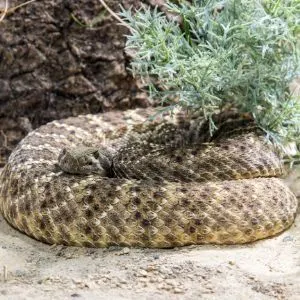
- Experience Level: Expert
- Family: Viperidae
- Scientific Name: Crotalus atrox
- Other Names: Texas Diamondback Rattlesnake
- Adult Size: up to 5 feet
- Lifespan: 15 to 20 years
Western Diamondback Rattlesnakes are typically dusty gray or brown with some pink-brown, brick red, yellow, chalky white, or pink. They also have dark gray or brown dorsal blotches throughout their body.
They have a triangular head and are heavy-bodied. Since it is, indeed a rattlesnake, we can’t forget to mention that it has a rattle at the end of its tail! This species has black and white stripes right underneath it, too.
These guys aren’t that picky about where they live and can be found in grassy plains, forests, coastal areas, deserts, and rocky hillsides.
They feed on small mammals like prairie dogs, gophers, squirrels, rabbits, chipmunks, mice, and rats. They might also eat a bird if it comes within its reach.
23. Great Basin Rattlesnake

- Experience Level: Expert
- Family: Viperidae
- Scientific Name: Crotalus oreganus lutosus
- Other Names: Great Basin Rattler
- Adult Size: 15 to 65 inches
- Lifespan: 17 years
The Great Basin Rattler is typically a medium-sized, hefty snake with a broad triangular head. They are usually a range of light brown, pale gray, olive-brown, yellow-brown, or grey with a row of brown blotches down the middle of their backs.
You can find them in barren flats, sagebrush, rocky hillsides, grassy plains, and agricultural areas. They feed on other reptiles, birds, their eggs, amphibians, and mammals.
Conclusion
That wraps it up for this list of snakes in Nevada. Whether you are a snake enthusiast in Nevada or just want to learn more about what you might find roaming the state in the wild, we hope this article has been helpful to you.
We also hope you learned a little more about the rules and laws of importing or possessing snakes in the state.
Leave us a comment down below about your experiences with rattlesnakes, if any!
We’d also love to hear your input about anything at all. Give us a shout-out if you’re from Nevada and have or want a snake.
Other snakes in states
